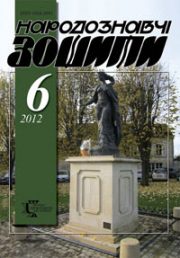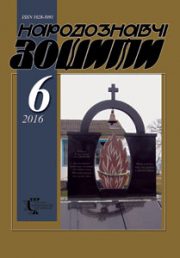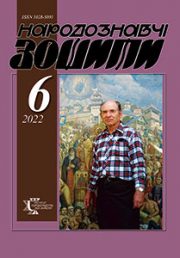The Ethnology Notebooks. 2024. № 5 (179), 1127—1136
UDK 398.332.4(=161.2:477.86/.87)
DOI https://doi.org/10.15407/nz2024.05.1127
SEREBRYAKOVA Olena
- ORCID ID: https://orcid.org/0000-0002-1039-2920
- Candidate of Historical Sciences (= Ph.D. in history).
- Senior researcher of the department of Modern Ethnology
- of the Ethnology Institute
- of the National Academy of Sciences of Ukraine,
- 15, Svobody Avenue, 79000, Lviv, Ukraine,
- Contacts: e-mail: o-sereb@ukr.net
Abstract. The aim of the offered article is coverage of the layer of customary and ritual, worldview phenomena associated with magical rites of economic direction. For this purpose, the information obtained during field research on the territory of Boykivshchyna region is introduced into scientific circulation, systematized and analyzed. The object of the research is the traditional worldview and customary-ritual culture of the residents of Boykivshchyna region, and the subject is the magic actions of sound imitation of the voices and behavior of domestic birds, in particular hens, which is made during the Christmas and Epiphany cycle of holidays. The ceremonial time, place (on the floor, under the table, in the corner or in the middle of the house, on the threshold, in the wicker basket) and the performers of magic actions (children, hostess, host, older family members) are set. The functional purpose, actional and verbal levels of the studied magic custom are revealed. Among the verbal magic, sayings, ritual dialogues are separate. Examples of contact and harmful magic are presented. The means of protective magic are considered. The use of Christmas attributes and ritual food with production semantics is also worth attention. The varieties, local differences, interpretations, beliefs, custom instructions, ritual taboos, are characterized. The archaic methods of increasing the number of hens in the household and the existence of additional rituals have been found. It is found that in some places of Boykivshchyna the researched custom has been preserved till nowadays.
The basis of the article are the materials of the field research, local history essays, works of the second half of the nineteenth and the beginning of the twenty-first centuries.
The methodology of this work is based on general scientific methodological principles and the basic requirements that apply to the works of historical and ethnological direction. The author uses a various methods (field observation, comparative-historical, comparative, reconstructive, structural-semantic).
Keywords: Boykivshchyna, Holy Evening, conception, beliefs, taboo, magic, hens.
Received 6.09.2024
REFERENCES
- Archive of the Institute of Ethnology of the National Academy of Sciences of Ukraine (hereinafter — Archive of the IE NASU). F. 1. Op. 2. Od. save 588. Arc. 1—123 [in Ukrainian].
- Archive of the IE NASU. F. 1. Op. 2. Od. save 590. Arc. 1—49 [in Ukrainian].
- Archive of the IE NASU. F. 1. Op. 2. Od. save 609. Arc. 1—65 [in Ukrainian].
- Archive of the IE NASU. F. 1. Op. 2. Od. save 787. Arc. 1—200 [in Ukrainian].
- Lepkyj, D. (1882). Folk customs and rites in the vicinity of Drohobych. Zoria, 2, 30—31 [in Ukrainian].
- Zubryts’kyj, M. (1900). Folk calendar, folk customs and beliefs tied to days of the week and annual holidays. Materialy do ukrains’koi etnol’ogii (Vol. III, pp. 33—60).Lviv [in Ukrainian].
- Archival scientific collections of manuscripts and audio recordings of M.T. Rylsky Institute of Art Studies, Folklore and Ethnology of the National Academy of Sciences of Ukraine (hereinafter — ASCMA IASFE NASU). F. 14—3. Act. 429. Arc. 1—150 [in Ukrainian].
- ASCMA IASFE NASU. F. 14—3. Act. 6. Arc. 1—128 [in Ukrainian].
- ASCMA IASFE NASU. F. 14—5. Act. 50. Arc. 1—140 [in Ukrainian].
- Turians’ka, M. (1934). Boyko’s customs from Christmas, New Year and Jordan. Litopys Bojkivschyny, 3, 23—27[in Ukrainian].
- Duchymins’ka, O. (1938). Christmas and St. Jordan customs in the village of Tyapcha (East Boykivshchyna). Litopys Bojkivschyny, 10, 55—59 [in Ukrainian].
- Archive of the IE NASU. F. 1. Op. 2. Od. save 317. Arc. 42—79 [in Ukrainian].
- Vasylechko, L. (1994). Palm Sunday. Folk customs, rites and beliefs. Broshniv: Talia [in Ukrainian].
- Hrom, H. (2002). Naguyevychi. Drohobych: Vidrodzhennia [in Ukrainian].
- Scientific archive of the Department of Ethnology and Local History, Faculty of History, Taras Shevchenko KNU (hereinafter — SADELHFH Taras Shevchenko KNU). F. 3. P. 3. Unit coll. 48. Arc. 1—95 [in Ukrainian].
- SADELHFH Taras Shevchenko KNU. F. 3. P. 5. Unit coll. 82. Arc. 1—36 [in Ukrainian].
- Archive of the IE NASU. F. 1. Op. 2. Od. save 533. Arc. 1—183 [in Ukrainian].
- Archive of the IE NASU. F. 1. Op. 2. Od. save 550. Arc. 1—205 [in Ukrainian].
- Zborovs’kyj, P. (2008). The Christmas cycle of holidays according to the tradition of the village of Verkhne Vysotske in the Turkiv region. The Ethnology notebooks, 1—2, 49—53 [in Ukrainian].
- Hladkyj, M. (2009). Christmas and New Year customs of the village of Dobrogostiv. Drohobytsk local history collection (Issue XIII, pp. 257—269). Drohobych: Kolo [in Ukrainian].
- Halajchuk, V. (2010). Traditional calendar customs and rites of the Staro Sambir region. Notes of the Shevchenko Scientific Society. Works of the ethnography and folklore section. Proceedings of the section of ethnography and folkloristics (Vol. CCLIX, pp. 138—178) [in Ukrainian].
- Kolomyjchuk, O. (2022). Calendar rites of Ukrainians of Boykivshchyna: autumn-winter cycle (end of the 19th century — 30s of the 20th century). Ivano-Frankivs’k: Symfoniia forte [in Ukrainian].
- Kuryvchak, I. (1981). Customs of the village of Korosna (Korostenka). Litopys Bojkivschyny, 2/34, 16—23 [in Ukrainian].
- Komarnyts’kyj, I. (1989).Christmas customs in the village of Lopushanka Khomyna, Turchany district. Litopys Bojkivschyny, 1/49, 67—69 [in Ukrainian].
- Onufryk, V. (1988). Rites and traditions of the village of Mykhnivets. Litopys Bojkivschyny, 2/48, 66—71 [in Ukrainian].
- (2020). Unity in diversity. Residents of Boykivshchyna: educational and methodological manual. L’viv; Zhytomyr [in Ukrainian].
- Scherbej, M. (1930). Holy evening. Nash rodnyj kraj, 3, 81—82 [in Ukrainian].
- Konopka, V. (2014). Volhynian «Folk’s Calendar» (after materials from the village of Vilhir and Kolesnyky in Goshcha district of Rivne region). The Ethnology notebooks, 2, 392—402 [in Ukrainian].
- Lutsiv, V.O. (1980). Customs and habits in Boykivshchyna. Boykivshchyna: monographic collection materials about Boykivshchyna from geography, history, ethnography and everyday life (Pp. 415—442). Filadel’fiia; Niu Jork [in Ukrainian].
- Burak, P. (1973). Holy evening in Boykivshchyna. Litopys Bojkivschyny, 1/18, 26—31 [in Ukrainian].
- Chekha, O.V., & Tolstoj, N.I. (Ed.). (2012). Sheaf. Slavic antiquities: an ethnolinguistic dictionary: in 5 vol. (Vol. 5, pp. 91—93). Moskva: Mezhdunarodnyje otnoshenija [in Russian].
- Archive of the IE NASU. F. 1. Op. 2. Od. save 654. Arc. 1—132 [in Ukrainian].
- Dovhun, V. (1927). Chickens. Nash rodnyj kraj, 5, 107—108 [in Ukrainian].
- Archive of the IE NASU. F. 1. Op. 2. Od. save 701. Arc. 1—104 [in Ukrainian].
- Rosokha, S. (1928). Holy evening. Nash rodnyj kraj, 4, 117—122 [in Ukrainian].
- Skrypnyk, H. (Ed.). (2016). Ethnographic image of modern Ukraine. Corps of expeditionary folklore and ethnographic materials. Calendar rituals (Vol. 6). NAN Ukrainy; IMFE named after M.T. Rylsky. Kyiv [in Ukrainian].
- (1887). Diary of folk holidays of Kharkov province. Khar’kovskyj sbornik (Issue 1, pp. 72—80). Khar’kov: Typohrafyia Hubernskoho Pravlenyia [in Russian].
- Dubyna, R. Christmas and New Year’s Ritual of the Population of Eastern Boykivshchyna (according to materials of expeditionary research). Retrieved from: https://www.pyrohiv.com/activities/rizdvyano-novorichna-obryadovist-naselennya-skhidnoi-boykivshchini-za-materialami-ekspeditsiynikh-do.html
- Belova, O.V., & Tolstoj, N.I. (Ed.). (2012). Straw. Slavic antiquities: an ethnolinguistic dictionary: in 5 vol. (Vol. 5, pp. 107—113). Moskva: Mezhdunarodnyje otnoshenija [in Russian].







